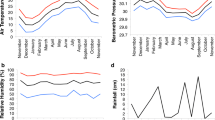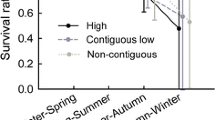Abstract
The chytrid fungus, Batrachochytrium dendrobatidis (Bd) has been linked to extinction and decline of numerous amphibians. We studied the population-level effects of Bd in two post-decline anuran species, Eleutherodactylus coqui and E. portoricensis, at El Yunque National Forest, Puerto Rico. Data on amphibian abundance was updated to report long-term population trends. Mark–recapture data was used to monitor Bd-infection status and estimate survival probabilities of infected versus uninfected adults. Prevalence of Bd (number of infected/total sampled) and individual infection level (number of zoospores) were compared among age classes at Palo Colorado Forest (661 m) and Elfin Forest (850 m). Results revealed that both species continued to decrease in Palo Colorado Forest, while in the Elfin Forest, E. portoricensis recuperated from drastic declines. Age class, season, and locality significantly predicted zoospore load. Age was also significantly associated with high zoospores loads among Bd-positive frogs, and the prevalence of Bd was higher in juveniles than adults in all populations studied. We suggest that early age represents a critical life stage in the survival of direct-developing frogs infected by this fungus. Survival probability was always higher for uninfected frogs, but recapture rates of infected versus uninfected adults were significantly different only in Palo Colorado, alerting that the negative effect of Bd infection under enzootic conditions is greater at mid-elevations. This work contributes to our understanding of how direct-developing amphibians persist with Bd, pointing to critical life stages and synergistic interactions that may induce fluctuations and/or declines in the wild.



Similar content being viewed by others
References
Alemu JB, Cazabon MNE, Dempewolf L, Hailey A, Lehtinen RM, Mannette RP, et al. (2008) Presence of the chytrid fungus Batrachochytrium dendrobatidis in populations of the critically endangered frog Mannophryne olmonae in Tobago, West Indies. EcoHealth 5:34–39
Beard KH, O’Neill EM (2005) Infection of an invasive frog Eleutherodactylus coqui by the chytrid fungus Batrachochytrium dendrobatidis in Hawaii. Biological Conservation 126:591–595
Beuchat CA, Pough FH, Stewart MM (1984) Response to dehydration and thermal stress in three species of Puerto Rican frogs. Journal of Comparative Physiology B 184:579–585
Bielby J, Cooper N, Cunningham AA, Garner TWJ, Purvis A (2008) Predicting susceptibility to future declines in the world’s frogs. Conservation Letters 1:82–90
Boyle DG, Boyle DB, Olsen V, Morgan JAT, Hyatt AD (2004) Rapid quantitative detection of chytridiomycosis (Batrachochytrium dendrobatidis) in amphibian samples using real-time Taqman PCR assay. Diseases of Aquatic Organisms 60:141–148
Briggs CJ, Knapp RA, Vredenburg VT (2010) Enzootic and epizootic dynamics of the chytrid fungal pathogen of amphibians. Proceedings of the National Academy of Sciences of the United States of America 107:9695–9700
Burrowes PA, Joglar RL, Green DE (2004) Potential causes for amphibian declines in Puerto Rico. Herpetologica 60:141–154
Burrowes PA, Longo AV, Joglar RL, Cunningham AA (2008a) Geographic distribution of Batrachochytrium dendrobatidis in Puerto Rico. Herpetological Review 39:321–324
Burrowes PA, Longo AV, Rodríguez CA (2008b) Potential fitness cost of Batrachochytrium dendrobatidis in Eleutherodactylus coqui, and comments on environment-related risk of infection. Herpetotropicos 4:51–57
Cooch E, White G (2008) Program Mark: A Gentle Introduction. http://www.phidot.org/software/mark/docs/book/. Accessed January 15, 2009
Díaz L, Cadiz A, Chong A, Silva A (2007) First report of chytridiomycosis in a dying toad (Anura: Bufonidae) from Cuba: a new conservation challenge for the island. EcoHealth 4:172–175
Ewel J, Whitmore J (1973) The ecological life zones of Puerto Rico and the U.S. Virgin Islands, Forest Service Research Paper IITF–18, Río Piedras, Puerto Rico: United States Department of Agriculture
Garland S, Baker A, Phillot AD, Skerratt LF (2009) BSA reduces inhibition in a TaqMan assay for the detection of Batrachochytrium dendrobatidis. Diseases of Aquatic Organisms (Preprint):1–4
Harris RN, Brucker RM, Walke JB, Becker MH, Schwantes CR, Flaherty DC, et al. (2009) Skin microbes on frogs prevent morbidity and mortality caused by a lethal skin fungus. The ISME Journal 3:818–824
Hedges SB, Duellman WE, Heinicke MP (2008) New World direct-developing frogs (Anura: Terrarana): molecular phylogeny, classification, biogeography, and conservation. Zootaxa 1737:1–182
Hyatt AD, Boyle DG, Olsen V, Boyle DB, Berger L, Obendorf D, et al. (2007) Diagnostic assays and sampling protocols for the detection of Batrachochytrium dendrobatidis. Diseases of Aquatic Organisms 73:175–192
IUCN, Conservation International, NatureServe (2009) An Analysis of Amphibians on the 2008 IUCN Red List. http://www.iucnredlist.org/amphibians/geographic_patterns. Accessed April 15, 2009
Joglar R (1998) Los Coquíes de Puerto Rico: Su Historia Natural y Conservación, San Juan, Puerto Rico: Editorial de la Universidad de Puerto Rico
Joglar RL, Burrowes PA (2005) Greater Antilles region progress report. Froglog 72:1–2
Kriger KM, Hero JM (2006) Survivorship in wild frogs infected with chytridiomycosis. EcoHealth 3:171–177
Kriger KM, Hero JM, Ashton KJ (2006) Cost efficiency in the detection of chytridiomycosis using PCR assay. Diseases of Aquatic Organisms 71:149–154
Lam BA, Walke JB, Vredenburg VT, Harris RN (2010) Proportion of individuals with anti-Batrachochytrium dendrobatidis skin bacteria is associated with population persistence in the frog Rana muscosa. Biological Conservation 143:529–531
Lips KR, Reeve JD, Witters LR (2003) Ecological traits predicting amphibian population declines in Central America. Conservation Biology 17:1078–1088
Lips KR, Brem F, Brenes R, Reeve JD, Alford RA, Voyles J, et al. (2006) Emerging infectious disease and the loss of biodiversity in a Neotropical amphibian community. Proceedings of the National Academy of Sciences of the United States of America 102:3165–3170
Longo AV, Burrowes PA, Joglar RL (2009) Seasonal patterns of Batrachochytrium dendrobatidis infection in direct-developing frogs suggest a mechanism for persistence in enzootic conditions. Diseases of Aquatic Organisms (Preprint):1–8
Malhotra A, Thorpe RS, Hypolite E, James A (2007) A report on the status of the herpetofauna of the Commonwealth of Dominica, West Indies. Applied Herpetology 4:177–194
Mendelson JR III, Lips KR, Gagliardo RW, Rabb GB, Collins JP, Diffendorfer JE, et al. (2006) Mitigating global amphibian extinctions: policy changes and action are needed. Science 313:48
Murray KA, Skerratt LF, Speare R, McCallum H (2009) Impact and dynamics of disease in species threatened by the amphibian chytrid fungus, Batrachochytrium dendrobatidis. Conservation Biology 23:1242–1252
Murray KA, Skerratt LF, Speare R, McCallum H (2010) Evidence of effects of endemic chytridiomycosis on host survival, behavior and emigration: reply to Schmidt. Conservation Biology (in press)
Nolan T, Hands R, Bustin S (2006) Quantification of mRNA using real-time PCR. Nature Protocols 1:1559–1582
Pilliod DS, Muths E, Scherer RD, Bartelt PE, Stephen Corn P, Hossack BR et al. (2010) Effects of amphibian chytrid fungus on individual survival probability in wild boreal toads. Conservation Biology (in press)
Puschendorf R, Bolaños F (2006) Detection of Batrachochytrium dendrobatidis in Eleutherodactylus fitzingeri: effects of skin sample location and histologic stain. Journal of Wildlife Diseases 42:301–306
R Development Core Team (2009) R: A Language and Environment for Statistical Computing. Vienna, Austria: R Foundation for Statistical Computing. ISBN 3-900051-07-0. http://www.R-project.org
Retallick RWR, McCallum H, Speare R (2004) Endemic infection of the amphibian chytrid fungus in a frog community post-decline. PLoS Biology 2:e351–e357
Richmond JQ, Savage AE, Zamudio KR, Rosenblum EB (2009) Toward immunogenetic studies of amphibian chytridiomycosis: linking innate and acquired immunity. BioScience 59:311–320
Rivero JA (1978) Los Anfibios y Reptiles de Puerto Rico, San Juan, Puerto Rico: Editorial de la Universidad de Puerto Rico
Rödder D, Veith M, Lötters S (2008) Environmental gradients explaining the prevalence and intensity of infection with the amphibian chytrid fungus: the host’s perspective. Animal Conservation 11:513–517
Rollins-Smith LA, Conlon JM (2005) Antimicrobial peptide defenses against chytridiomycosis, an emerging infectious disease of amphibian populations. Developmental and Comparative Immunology 29:589–598
Rowley J, Alford RA (2007) Behaviour of Australian rainforest stream frogs may affect the transmission of chytridiomycosis. Diseases of Aquatic Organisms 77:1–9
Schmidt BR (2010) Estimating the impact of disease in species threatened by amphibian chytrid fungus: comment on Murray et al. Conservation Biology (in press)
Stewart MM, Woolbright LM (1996) Amphibians. In: Reagan T, Waide RB (eds) The Food Web of a Tropical Rain Forest. University of Chicago Press, Chicago, pp. 273–320
Stuart SN, Chanson JS, Cox NA, Young BE, Rodrigues ASL, Fischman DL, et al. (2004) Status and trends of amphibian declines and extinctions worldwide. Science 306:1783–1786
Twitty V (1966) Of Scientists and Salamanders, San Francisco: Freeman
Walker SF, Bosch J, Gómez V, Garner TWJ, Cunningham AA, Schmeller DS, et al. (2010) Factors driving pathogenicity vs. prevalence of amphibian panzootic chytridiomycosis in Iberia. Ecology Letters 13:372–382
Whiles MR, Lips KR, Pringle CM, Kilham SS, Bixby RJ, Brenes R, et al. (2006) The effects of amphibian population declines on the structure and function of Neotropical stream ecosystems. Frontiers in Ecology and the Environment 4:27–34
Woolbright LL (1985) Patterns of nocturnal movement and calling by the tropical frog Eleutherodactylus coqui. Journal of Herpetology 41:1–9
Acknowledgments
Many students in the Joglar/Burrowes Laboratory made this study possible, especially C. A. Rodríguez and A. López who were exceptional in the field. R. L. Joglar shared lab facilities and provided stimulating discussions on E. coqui biology. S. Ward revised earlier versions of this manuscript. We thank S. Ayala and B. Bolaños at MSC-UPR for sharing their laboratory equipment for Bd diagnosis and culture. D. Boyle at CSIRO Australia provided zoospore equivalent standards for qPCR detection of Bd. Financial support was provided by UPR-FIPI, Proyecto Coquí, and NSF-Funded PRLSAMP (Grant no. HRD-0114586) and NSF-Funded CREST-CATEC (Grant no. HRD-0734826) Programs. Amphibian tissues and animals were collected under the Puerto Rico Department of Natural Resources permit numbers: DRNA 04-IC-003, 04-IC-062, 05-IC-051-052, and 06-IC-039-IC-052.
Author information
Authors and Affiliations
Corresponding author
Rights and permissions
About this article
Cite this article
Longo, A.V., Burrowes, P.A. Persistence with Chytridiomycosis Does Not Assure Survival of Direct-developing Frogs. EcoHealth 7, 185–195 (2010). https://doi.org/10.1007/s10393-010-0327-9
Received:
Revised:
Accepted:
Published:
Issue Date:
DOI: https://doi.org/10.1007/s10393-010-0327-9




